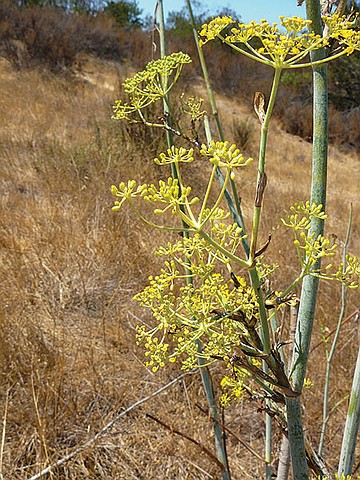 Facebook
Facebook
 X
X
 Instagram
Instagram
 TikTok
TikTok
 Youtube
Youtube

The highlights of this short hike include the transition from grasslands and coastal sage scrub habitats to small shaded oak woodland with majestic coast live oaks and rare Engelmann oaks found along a stream where a replica of a Kumeyaay home is found. The inviting shady area also has benches where one can sit and enjoy the butterflies and dragonflies that often visit. Interpretive panels tell about the Kumeyaay that once called this area home.

The hike begins across from the entrance to the parking area for the Mission Trails Visitor Center. The best direction to do the loops is to begin by going left (north). That way the small loop can be made by turning right after 0.24 mile and hiking back to the starting area to begin the larger loop. When reaching the original 0.24-mile spot, which is now mile 0.76, turn left to do the large loop. The high points ahead of you are Kwaay Paay on the left and Pyles Peak on the right, on the other side of Mission Gorge.
Another small loop begins at 0.83. Go right to complete the smaller loop and rejoin the main trail at 1.09 miles. On this smaller loop, look for sweet fennel (Foeniculum vulgare). Sweet fennel is an invasive plant that originally comes from the Mediterranean area and thrives in coastal sage scrub and grasslands. It is an erect tall herb with a characteristic licorice/anise smell, feathery leaves, and yellow flowers that are clustered in a large (up to four inches) umbel — an umbrella-like arrangement. In the Mediterranean region, it has been used as a spice for centuries. Do not mistake poison hemlock, a native plant in San Diego, for fennel. Poison hemlock does not smell of licorice and has reddish blotches on the stems.

Invasive nonnative plants are a problem, as they compete for resources and are often more aggressive than the native plants and end up squeezing them out of their own niche. Other harmful invasive plants include giant reed, artichoke thistle, pampas grass, and salt cedar (or tamarisk). All are found within Mission Trails Regional Park.
As soon as the main loop trail is rejoined, the coastal sage scrub immediately transitions to thick oak woodland, then the elevation descends toward a small stream. At mile 1.15, a Kumeyaay ’ewaa (house) appears beneath the shaded oak canopy. Typically, the frame for the dome-shaped dwellings was made from strong willow or sycamore branches lashed together with strips of bark. Slimmer leaved willow branches were then weaved into the framework. Benches are located along this shady path.
The trail joins the paved path at mile 1.43. Turn left and walk back toward the visitor center entrance, where the loop began.


The highlights of this short hike include the transition from grasslands and coastal sage scrub habitats to small shaded oak woodland with majestic coast live oaks and rare Engelmann oaks found along a stream where a replica of a Kumeyaay home is found. The inviting shady area also has benches where one can sit and enjoy the butterflies and dragonflies that often visit. Interpretive panels tell about the Kumeyaay that once called this area home.

The hike begins across from the entrance to the parking area for the Mission Trails Visitor Center. The best direction to do the loops is to begin by going left (north). That way the small loop can be made by turning right after 0.24 mile and hiking back to the starting area to begin the larger loop. When reaching the original 0.24-mile spot, which is now mile 0.76, turn left to do the large loop. The high points ahead of you are Kwaay Paay on the left and Pyles Peak on the right, on the other side of Mission Gorge.
Another small loop begins at 0.83. Go right to complete the smaller loop and rejoin the main trail at 1.09 miles. On this smaller loop, look for sweet fennel (Foeniculum vulgare). Sweet fennel is an invasive plant that originally comes from the Mediterranean area and thrives in coastal sage scrub and grasslands. It is an erect tall herb with a characteristic licorice/anise smell, feathery leaves, and yellow flowers that are clustered in a large (up to four inches) umbel — an umbrella-like arrangement. In the Mediterranean region, it has been used as a spice for centuries. Do not mistake poison hemlock, a native plant in San Diego, for fennel. Poison hemlock does not smell of licorice and has reddish blotches on the stems.

Invasive nonnative plants are a problem, as they compete for resources and are often more aggressive than the native plants and end up squeezing them out of their own niche. Other harmful invasive plants include giant reed, artichoke thistle, pampas grass, and salt cedar (or tamarisk). All are found within Mission Trails Regional Park.
As soon as the main loop trail is rejoined, the coastal sage scrub immediately transitions to thick oak woodland, then the elevation descends toward a small stream. At mile 1.15, a Kumeyaay ’ewaa (house) appears beneath the shaded oak canopy. Typically, the frame for the dome-shaped dwellings was made from strong willow or sycamore branches lashed together with strips of bark. Slimmer leaved willow branches were then weaved into the framework. Benches are located along this shady path.
The trail joins the paved path at mile 1.43. Turn left and walk back toward the visitor center entrance, where the loop began.